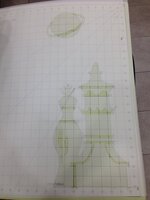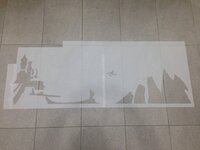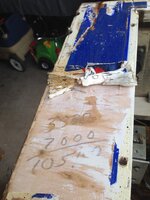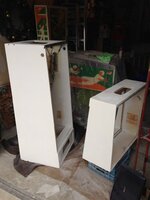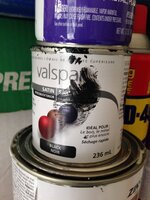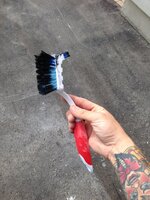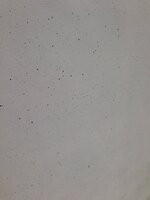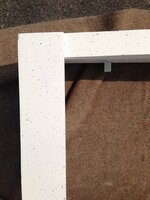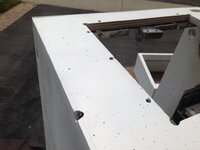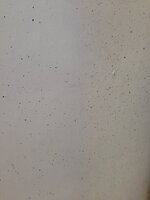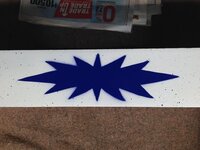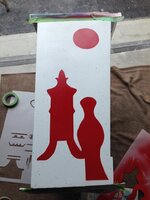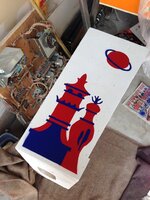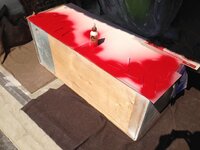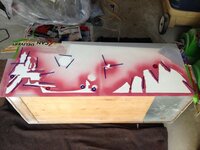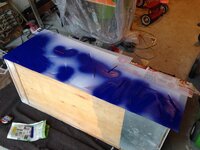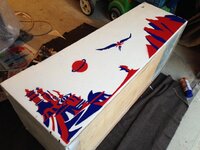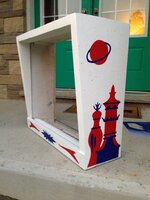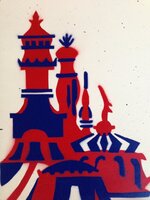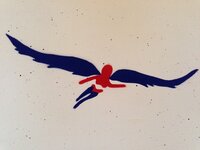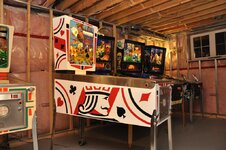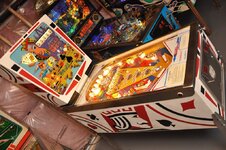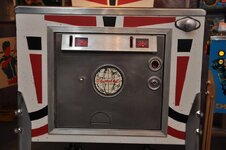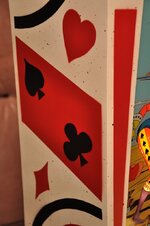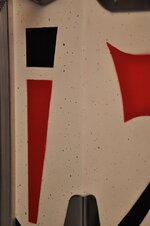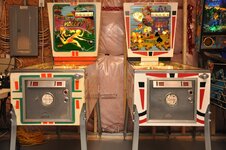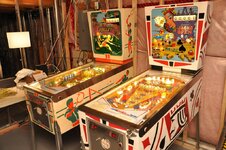It has been a while since I've added something semi-productive to this site, so I decided to chronicle the face lift I gave my Gottlieb Solar City cabinet. I hesitate to use the word “restore” because it is an overused term in this hobby. I tried to bring the cabinet back to factory original, however, I'm no Christopher Hutchins (or Christoofur Hoochens as he's known around these parts) and the work isn't perfect by any stretch of the imagination. Some may cringe that I repainted the cabinet to begin with. Well, too bad. Its my pinball machine and I think it looks better for it.
I had only attempted a cabinet stenciling once before, and it wasn't a full blown production like the Solar City re-stenciling would be. Last fall, I gave the cabinet of my Gottlieb Charlie's Angels a face lift, by repainting the purples which time had turned to a muddy gray. I cut stencils out of a think glossy presentation paper, masked off the areas I didn't want getting blasted and went to town with a can of rattle-can Rustoleum, spraying right over top of the faded purples. The remnants of that stencil still hang on the wall of my garage, and are all that remain of the game—it was sold the following spring. That process turned out alright, but the cabinet still had nicks and scratches in other areas that I tried to touch up, but as anyone who has tried to touch up a cabinet in the past knows, matching the colour and texture is a tough, near impossible, task. Also, the Rustoleum purple I used was also a little too glossy for my liking. It made the silhouette of the Angles pop, but was far too glossy to look factory original.
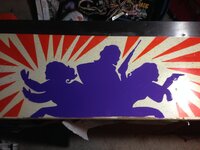
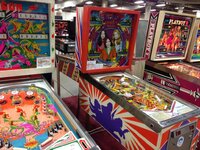
Left: The Angels repainted. Right: The game as it appeared on display in Allentown.
About a month ago, I picked up my first two EM machines from PBRev stalwart Warlock: a Gottlieb single-player wedgehead Big Hit, and a Gottlieb two-player Solar City. Both needed minor adjustments, but both were pretty much plug and play. While Big Hit maintained its original splendor with a fantastic playfield and cabinet, Solar City left a lot to be desired. The playfield was filthy, had multiple wear spots and had two of the always pleasant, over-sized, non-factory Robertson screws that had broken through to the top of the playfield from beneath. The cabinet had a lot of scrapes and bruises, too. I'm told only now (after the project was complete) that the cabinet would be considered “not bad” by EM standards as it arrived in my care...but to me, there was just a bit too much wear for my liking.
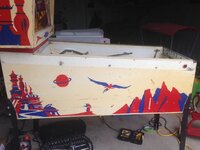
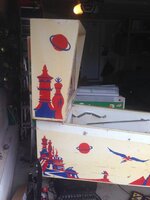
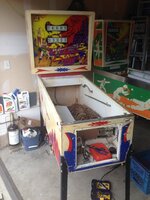
"Before" shots of the cabinet
A word or two about Solar City, I suppose, before I begin. It is known as the red-headed step-child of the El Dorado-Gold Strike-Canada Dry-Target Alpha series. All of the games have the same layout with different art packages. The layout remains uber-popular to this day: everyone loves drop targets, and this one has an absolute ton. It also has the longest undisturbed shot in pinball, a record that still stands: the shot from the lower left flipper to the furthest right drop target in the upper bank. The lack of a traditional upper arch allows for the extra inches to make the record...go ahead, measure it. El Dorado, the one-player wedgehead, led the way in the series, followed by its add-a-ball and export brethren, carrying a wild west theme. Canada Dry was a licensed theme for export to help promote the ginger ale soft drink. Target Alpha arrived with some great futuristic artwork (second only to Gottlieb's Jet Spin, in my opinion) in a four-player version of the El Dorado layout. Solar City was a bit of an after thought as a two-player version. It has a unique backglass and cabinet art, but the graphics seem to be a bit more subdued (and less inspired) than Target Alpha. Where Target Alpha epitomized 1970s sci-fi cool, Solar City seemed approach the theme from a less exciting fantasy style. The final nail in the coffin is driven in because Gottlieb didn't bother to manufacture a unique set of plastics for the game...they just changed the colour scheme of the Target Alpha plastics for use on Solar City--so you've got characters on the plastics that bear no reference to the Solar City characters on the backglass! The main drawback about Target Alpha/Solar City gameplay, is that the drop targets will not reset if you can knock them all down in one ball like the one-player series of games will. Also, there is no moving lit target paired with the drop targets to chase on the multi-player game, whereas it is an integral feature to score loads of points in the El Dorado series.
So why Solar City? Frankly, it was there. And it was something I could work with. And I love the layout, but there was no way I would pay the price El Dorado commands. Also, Gottlieb two-player games were always the rarer of the box-head multi-player games: they made 7,285 of Target Alpha but only 2,875 Solar Citys. Further, if I wanted to really play the restoration game, a new Solar City backglass is readily available from Classic Playfield Reproductions, which is more than can be said for other games of the same vintage (Solar City's purchase-mate, Big Hit for example has no reproduction glass on the market). I'd be painting myself into a corner with bringing this game back to life: I'd never get back the money I'd be sinking into it, but that's not why I'm doing it. Wait, why am I doing it again...? Or right, for the love of pinball.
Con't...
I had only attempted a cabinet stenciling once before, and it wasn't a full blown production like the Solar City re-stenciling would be. Last fall, I gave the cabinet of my Gottlieb Charlie's Angels a face lift, by repainting the purples which time had turned to a muddy gray. I cut stencils out of a think glossy presentation paper, masked off the areas I didn't want getting blasted and went to town with a can of rattle-can Rustoleum, spraying right over top of the faded purples. The remnants of that stencil still hang on the wall of my garage, and are all that remain of the game—it was sold the following spring. That process turned out alright, but the cabinet still had nicks and scratches in other areas that I tried to touch up, but as anyone who has tried to touch up a cabinet in the past knows, matching the colour and texture is a tough, near impossible, task. Also, the Rustoleum purple I used was also a little too glossy for my liking. It made the silhouette of the Angles pop, but was far too glossy to look factory original.


Left: The Angels repainted. Right: The game as it appeared on display in Allentown.
About a month ago, I picked up my first two EM machines from PBRev stalwart Warlock: a Gottlieb single-player wedgehead Big Hit, and a Gottlieb two-player Solar City. Both needed minor adjustments, but both were pretty much plug and play. While Big Hit maintained its original splendor with a fantastic playfield and cabinet, Solar City left a lot to be desired. The playfield was filthy, had multiple wear spots and had two of the always pleasant, over-sized, non-factory Robertson screws that had broken through to the top of the playfield from beneath. The cabinet had a lot of scrapes and bruises, too. I'm told only now (after the project was complete) that the cabinet would be considered “not bad” by EM standards as it arrived in my care...but to me, there was just a bit too much wear for my liking.



"Before" shots of the cabinet
A word or two about Solar City, I suppose, before I begin. It is known as the red-headed step-child of the El Dorado-Gold Strike-Canada Dry-Target Alpha series. All of the games have the same layout with different art packages. The layout remains uber-popular to this day: everyone loves drop targets, and this one has an absolute ton. It also has the longest undisturbed shot in pinball, a record that still stands: the shot from the lower left flipper to the furthest right drop target in the upper bank. The lack of a traditional upper arch allows for the extra inches to make the record...go ahead, measure it. El Dorado, the one-player wedgehead, led the way in the series, followed by its add-a-ball and export brethren, carrying a wild west theme. Canada Dry was a licensed theme for export to help promote the ginger ale soft drink. Target Alpha arrived with some great futuristic artwork (second only to Gottlieb's Jet Spin, in my opinion) in a four-player version of the El Dorado layout. Solar City was a bit of an after thought as a two-player version. It has a unique backglass and cabinet art, but the graphics seem to be a bit more subdued (and less inspired) than Target Alpha. Where Target Alpha epitomized 1970s sci-fi cool, Solar City seemed approach the theme from a less exciting fantasy style. The final nail in the coffin is driven in because Gottlieb didn't bother to manufacture a unique set of plastics for the game...they just changed the colour scheme of the Target Alpha plastics for use on Solar City--so you've got characters on the plastics that bear no reference to the Solar City characters on the backglass! The main drawback about Target Alpha/Solar City gameplay, is that the drop targets will not reset if you can knock them all down in one ball like the one-player series of games will. Also, there is no moving lit target paired with the drop targets to chase on the multi-player game, whereas it is an integral feature to score loads of points in the El Dorado series.
So why Solar City? Frankly, it was there. And it was something I could work with. And I love the layout, but there was no way I would pay the price El Dorado commands. Also, Gottlieb two-player games were always the rarer of the box-head multi-player games: they made 7,285 of Target Alpha but only 2,875 Solar Citys. Further, if I wanted to really play the restoration game, a new Solar City backglass is readily available from Classic Playfield Reproductions, which is more than can be said for other games of the same vintage (Solar City's purchase-mate, Big Hit for example has no reproduction glass on the market). I'd be painting myself into a corner with bringing this game back to life: I'd never get back the money I'd be sinking into it, but that's not why I'm doing it. Wait, why am I doing it again...? Or right, for the love of pinball.
Con't...

